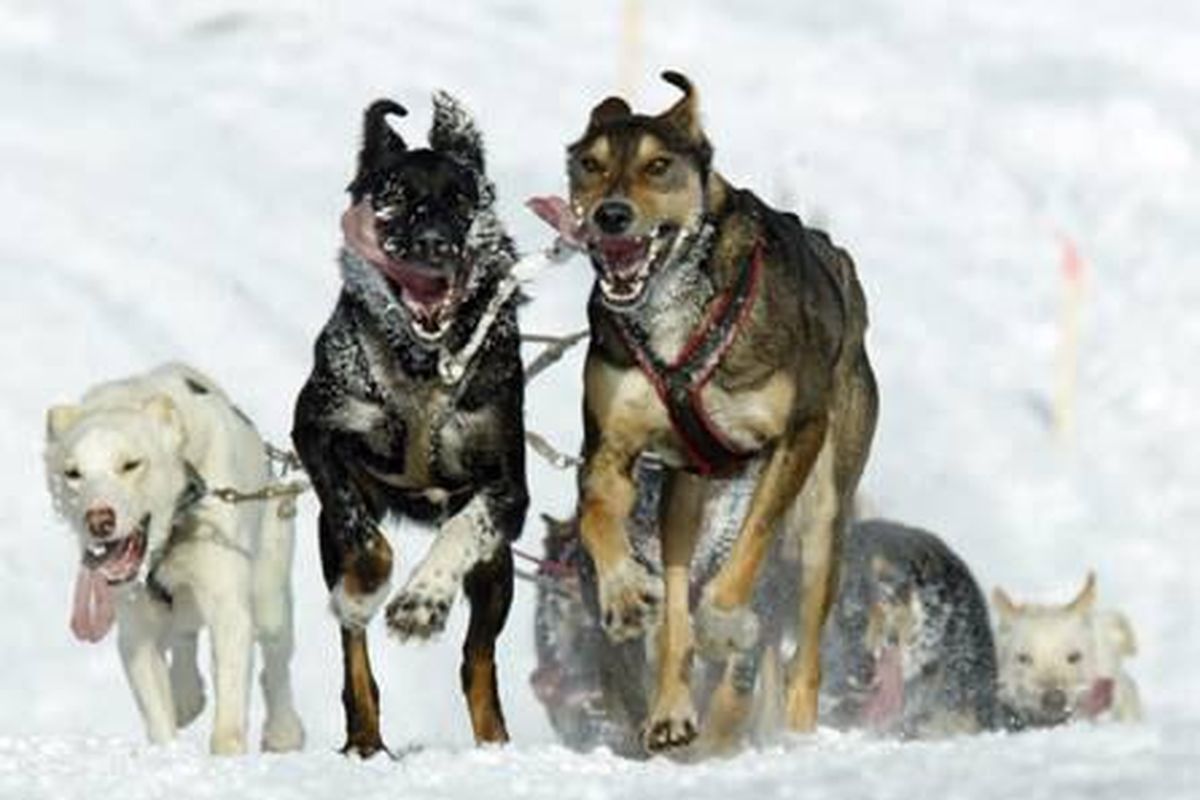Alaskan huskies bred for all-around sledding performance

The breed of dog used by most dog mushers in Alaska isn’t really a breed, at least not in the way kennel clubs think of pedigree.
The “Alaskan husky” is an amalgamation of breeds that’s changed as mushers look for different attributes in dogs. You’ll see many of them – some with bloodlines linked to bird-hunting pointing dogs – in the big races this season like the Yukon Quest and Iditarod.
Champion sprint musher Arleigh Reynolds describes the Alaskan husky as “a purpose-based breed – a dog that is bred to do something.
“It doesn’t matter what color they are,” he said. “What matters is how they function. A purebred dog may have a function, like retrievers, but they’re also bred for appearance.”
Reynolds is the associate dean of the veterinary medicine program at the University of Alaska Fairbanks. He likes Alaskan huskies because the risk of genetic disorders is lower when breeding dogs that aren’t closely related.
It has also worked well for him. Reynolds breeds his own dogs and has won both of Alaska’s main sprint mushing races – the Open North American in Fairbanks and the Fur Rendezvous in Anchorage.
Purpose-based breeding differentiates the Alaskan husky from the Siberian husky, a type of dog sometimes used in distance mushing. It’s classified as a purebred dog by the American Kennel Club.
Siberian huskies have to be bred with other Siberian huskies to retain their pedigree. There is one team of Siberians running the 2017 Yukon Quest, the team of Ontario musher Hank DeBruin.
Leonhard Seppala – a hero of the 1925 serum run to Nome – used Siberian huskies, but they were an early descendant of today’s breed.
“Most dogs came from the Chukchi Peninsula, and they were working dogs and they didn’t all have masks (dark-colored fur over the eyes) and they didn’t all have tails that came up and curled over the back,” Reynolds said. “His dogs look exactly like our Alaskan huskies.”
Other purebred dogs that have been used for dog mushing include Alaskan malamutes and chinooks, a sled dog breed developed in New Hampshire in the early 20th century.
In the late 1980s and early 1990s, an Anchorage Iditarod musher famously raced a team that included standard poodles.
The appearance of the Alaskan husky took a turn in the mid- to late-1990s, when European mushers began breeding hound-type dogs with Alaskan huskies, Reynolds said. The transformation began because at the time dogs had to spend up to a year in quarantine traveling between North America and Europe.
European mushers brought a few Alaskan huskies and bred them with the German short-haired pointers that were popular dogs for pulling pulk sleds in Scandinavia.
The crossbred offspring of the Alaskan huskies and the pointers made good mushing dogs. The type of dog, sometimes known as a Eurohound, became widely used in the mushing world, Reynolds said.
“They started in Scandinavia and went as far down as Italy and Spain. And then they came over here,” Reynolds said. “1998 was the first year we really had very many of those dogs (in Alaska), on (Swedish sprint musher) Egil Ellis’ team.”
European hunting dog breeds now included in the Alaskan husky gene pool include German shorthairs, English pointers and, to a smaller degree, greyhounds.
Alaskan huskies often look much like their Alaska “village dog” ancestors, even when they have a lot of pointer blood, Reynolds said.
“You can breed anything into that dog and the cool thing is the husky is so predominant a generation or two down the line you end up with a dog that looks like a husky,” he said. “You may have brought in a trait and some genetic diversity, but by and large you end up with huskies again.”
In recent generations the transformation of the Alaskan husky has led to the bifurcation of competitive dogs into different categories. Shorter-haired Alaskan huskies tend to be sprint dogs because they’re better at shedding heat from their bodies. Distance dogs need to be stronger to pull a heavy sled and to have longer coats to endure cold temperatures on overnight trips.
Mushers used to use the same dogs regardless of whether they were going 20 miles or 1,000 miles.